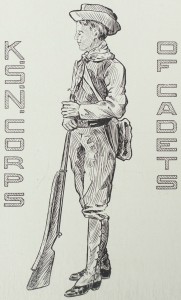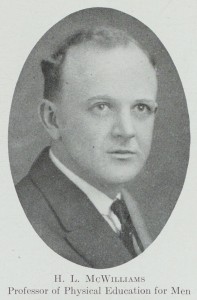Student Soldiers
The years 1914-1918 were a tumultuous time for the Kirksville State Normal School, as it was dubbed by those who called it home. Technically, the school was officially named the First District Normal School from December 1870 to 1919 when it was renamed the Northeast Missouri State Teachers College; however, students during the Great War period all referred to the college as the Kirksville State Normal School or K.S.N.S. Today, the K.S.N.S. is Truman State University.
The Cadet Corps
Prior to the First World War, the K.S.N.S. had a Cadet Corps to, according to President John R. Kirk, make men “‘healthier and stronger in body and more manly in appearance and conduct’.”1 The Corps’s creation was delayed when guns failed to arrive on time and was not fully established until the fall of 1904 when fifty stands of vintage rifles from the Spanish-American War finally arrived in Kirksville. The first Corps had thirty young men under the charge of S. S. Carroll. By 1905, the Corps had forty-seven members.2 Frank Ward, a corporal of the corps in 1905 and graduate of the K.S.N.S. in 1913 took charge of the Cadet Corps. When Ward graduated during the 1910-1911 school year and no faculty members were qualified to take over command, the Corps was disbanded. Ward entered the United States Army in 1917. While serving in the Great War, Ward earned the rank of captain and served with the historic 32nd Division in France.3
After the United States entered the war in Europe in April 1917, President Kirk reinstated tactical military training at the K.S.N.S. Led by Captain Leo M. Ewing, a sixty-man corps was organized during the summer quarter of 1918 — some of these men eventually saw action in France. That summer, a military organization of ninety women was led by H.L. McWilliams, head of physical education for men.4 These corps drilled the athletic field, known later as Kirk field, during fine weather and inside the new gymnasium inside Science Hall when weather was foul. The corps also ventured into the woods west of Kirksville for overnight camping trips.5
The Student Army Training Corps
In a letter issued May 8, 1918, Secretary of War Newton D. Baker outlined his plan for military instruction within the nation’s colleges. Baker called for colleges with enrollments of at least one-hundred able-bodied men of at least eighteen years of age to furnish officers for the United States Army and provide such men with direct military instruction.6 This Student Army Training Corps allowed young men to continue their college education while also preparing themselves for military service. Importantly, by prolonging the education and training of these capable individuals, the War Department prevented premature enlistment in the armed forces.7
After reading Baker’s letter, President Kirk applied for a Student Army Training Corps unit to be established at the K.S.N.S. President Kirk and Dean Ziegel, as well as other faculty members, began a campaign to attract young men to the Normal School and get them to enlist in the Student Army Training Corps.8 This campaign took K.S.N.S. representatives to every county in the Normal School district. In order for the War Department to approve the application, Kirk needed at least one hundred qualified enrollees. By the middle of July, President Kirk had 176 applications with 161 acceptable men.9
The S.A.T.C. application was approved on September 4, 1918 and Second Lieutenant Donald S. Johnson arrived at the end of the month to take command. He was assisted by Second Lieutenant Leo M. Ewing, his personal adjutant; Second Lieutenant Den A. Strickland, the small arms instructor; Harry L. McWilliams, professor of physical education and head of the physical training program; and First Sergeant Atteberry. As spectators filled the bleachers, at Kirk Field on October 1, 1918, Lieutenant Johnson directed 161 young men taking of the oath of allegiance to the Student Army Training Corps. The young men of the unit found little to criticize in the program and were generally pleased with the food provided by Mary M. Baird, the head of the first cafeteria at the K.S.N.S. The men of the S.A.T.C. admired and liked their officers, especially Lieutenant Johnson who was said to be kind and considerate even in the most difficult circumstances.10
The men of the S.A.T.C. were housed in various places around campus. Some were housed in on-campus barracks, others in private residences in Kirksville. Sixty-two men lived in the gymnasium of the Library Building; twenty-five bunked in the Model Rural School. The rest were distributed in Kirksville homes. All school activities, including class schedules, were adjusted to fit the needs of the men in the corps. When its hours proved inconvenient, the reading room of the library was reserved each evening exclusively for the study hours of the S.A.T.C. men.11
Page Images:
1. “Corps of Cadets,” The Echo: 1906, p. 149, Pickler Memorial Library, Truman State University.
2. “H.L. McWilliams,” The Echo: 1917, p. 19, Pickler Memorial Library, Truman State University.
Footnotes:

